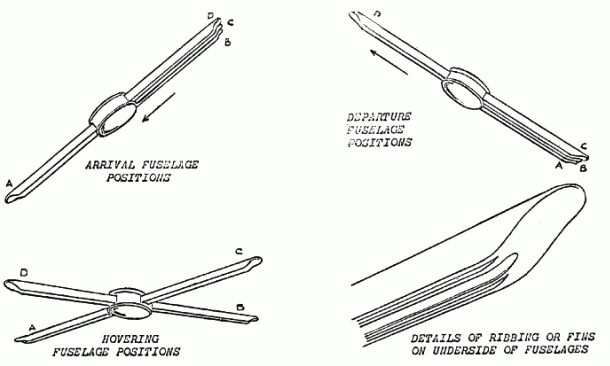

|
Volume IV, No. 4 - January - February, 1968 - Pages 4-5
IMPORTANT NEW DETAILS ON FLYING CROSS
The British "flying cross" sighting, reported briefly in the last issue (IV -3), has assumed new significance
because of the extensive aviation background of the observer and new details he has now supplied.
The witness in the "flying cross" case was Mr. Angus Brooks, for years a flying officer of the British Overseas Airline Corporation. In World War II, Mr. Brooks was a military photographic interpreter. Prior to this, he attended art school, acquiring experience which fortunately enabled him to make several precise sketches of the strange-looking device, as shown below.
The flying-cross sighting occurred on Oct. 26, 1967. It was a clear, sunny day, and Mr. Brooks was walking near the south coast of England, accompanied by his two dogs. The aviation expert noticed a vapor trail high in the sky. The trail vanished and a strange-looking craft appeared from the same area, descending at great speed until It was 200-300 feet above the ground and approximately one-fourth of a mlle distant.
Mr. Brooks' description was as follows:
"The shape of the 'craft' prior to levelling out to 'hover' position was of a central circular chamber (estimated 25 feet in diameter, 12 feet high) with a leading fuselage in the front and three separate fuselages together at the rear. (Each of the four was 75 feet long, 7 feet high, 8 feet wide.)
"On slowing to hover position, the two outer fuselages at the rear moved to position at side of craft to form four fuselages at equidistant position around the centre chamber. There were no visible power units and no noise of applied power for reverse thrust, movement of fuselages or for 'hovering.' On attaining 'hover,' the 'craft' rotated 90 degrees clockwise and then remained motionless, unaffected by very strong wind.
"From my position, the 'craft's' construction was of a translucent material -- the colour of the 'craft' took on the colour of the sky above it and changed with clouds passing over it. There could have been a clear material at the top of fuselages and centre chamber. There were dark centre shadows along the bases of the fuselages and centre chamber. No movement was observed at any time of the operators-no portholes or crew viewing windscreens at nose of fuselages. The nose cones of the fuselages were the reverse to our conventional types -- the groove fins along the bases of the fuselages did not open or close."

The scene of the sighting was equidistant between Winfrith Atomic Station and the Portland Underwater
Defence Station, and about a mile from a U.S, Air Force Communications Unit at Ringstead Bay.
During the UFO's descent and the period of hovering, Mr.
Brooks' two dogs were extremely agitated. The "flying cross" UFO hovered in the same
position for 22 minutes before it prepared to take off.
"Two of the fuselages moved around to line up with a centre third," reported Mr. Brooks, "and the 'craft' climbed with speed increasing . . . . The lead fuselage on departure was a different one to the arrival 'lead."
(The report stated that one of the dogs, a large Alsatian, died a few weeks later, but there was no implication that thls was connected with the UFO.)
Since the British Royal Observatory is investigating UFO reports, probably it will thoroughly evaluate
this unusual case. We shall attempt to secure their evaluation through Mr. Julian Hennessey, NICAP's special investigator in England, who secured the original report from Mr. Brooks, at Owermoigne, Dorset.
As stated in ihe previous issue, five other "flying cross" UFOs were sighted over the British Isles in October, 1967. Over a period of years, there have been a few similar reports mostly without detalls or unconfirmed, and usually put down as errors or optical illusions.
But the six cases in October revived the question, and now with this detailed report from an unusually experienced and reputable observer, it appears that "flying cross" UFOs actually exist.
From an aerodynamic standpoint, it would not be difficult to construct a craft such as the aviation expert describes. We already have aircraft with movable wings which can be swung back toward the fuselage to decrease air resistance and thus increase speed. The movable sections described by Mr. Brooks, however, do not appear to have this primary purpose, since they remained extended while the craft hovered.
Any discussion of the purpose must be pure guesswork. We might speculate that the movable sections, or "fuselages" as Mr. Brooks terms them, contained unusual observational equipment. It might be designed to secure scientific Information about the atomic station; it could be photographic equipment, or electronic devices to monitor or record communications. Or there could be some motive beyond our present understanding.
Regardless, we shall now carefully reexamine recent and earlier "flying cross" reports for clues to the purpose and operation of this unusual type of UFO. If any members know of such reports, new or old, we shall appreciate receiving the information.
We are indebted to Mr. Hennessey for his prompt and efficient investigation of this sighting, as well as other important reports from the British Isles and also the European continent.
|